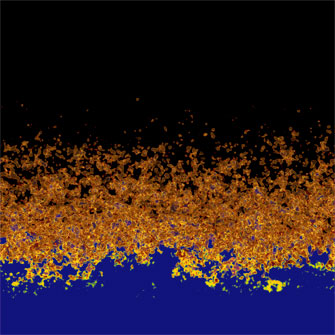The Early Universe, Large Scale Structure and Cosmic Microwave Background
CITA researchers are involved in all aspects of physical cosmology, from inflation to the epoch of recombination when the cosmic microwave background (CMB) was emitted, to the structure formation of the present-day universe.
A common thread in all of these studies are cosmic expansion and primordial fluctuations. Expansion is an empirical fact of our universe and key to understanding its matter and energy content. Without primordial fluctuations, the universe would be perfectly smooth and featureless, devoid of all planets, stars, and galaxies — a very dull place indeed.
What process generated the cosmic expansion and primordial fluctuations in the first few instants in the universe? Further, how did the primordial fluctuations evolve in the expanding universe, generating CMB anisotropies and finally culminating in the grand “cosmic web” of large-scale structure that we see today? CITA cosmologists are involved in both theoretical and observational aspects of these problems.
Early universe work at CITA is mainly theoretical, focusing on the theory that relates the early phase of nearly exponential expansion known as inflation to high-energy particle physics, and its predictions for the CMB and large scale structure. Specific problems under consideration include primordial non-Gaussianity, multifield inflation, and preheating from parametric resonance. This work provides the crucial link between astronomical observations and fundamental physics.
As the flood of new CMB data continues to come in from experiments such as the Planck satellite and the Atacama Cosmology Telescope (ACT), the efficient analysis and interpretation of data becomes increasingly important. This involves processing the raw observational maps to remove foreground obscuration and determine statistical measurements of underlying physical quantities such as the “power spectrum” of primary and secondary CMB anisotropies.
Observations with the Canadian Hydrogen Intensity Mapping Experiment (CHIME) promise to revolutionize our understanding of the mysterious “dark energy” that is causing the expansion of the universe to accelerate, by determining the angular size in the sky of so-called baryonic acoustic oscillations (BAO), using a technique known as hydrogen intensity mapping. After initially proposing the idea some years ago, CITA researchers are now involved in the design of intensity mapping experiments, foreground removal, and power spectrum estimation, in much the same way as in the CMB analysis effort.
Cosmological N-body simulations run on SciNet supercomputers are being used to make precise predictions for application to a wide array of observations, including CHIME and large galaxy surveys such as the Canada France Hawaii Telescope Lensing Survey (CFHTLenS). At the same time, the analytical framework for the nonlinear growth of dark matter fluctuations into the cosmic web, developed at CITA over the last 25 years, is now being applied to observations of secondary CMB anisotropies and the cosmic infrared background with Planck, ACT, and Herschel.
All-sky Interferometry with Spherical Harmonic Transit Telescopes
Shaw, J. Richard; Sigurdson, Kris; Pen, Ue-Li; Stebbins, Albert; Sitwell, Michael.
The Astrophysical Journal, Volume 781, Issue 2, article id. 57, 9 pp. (2014)
arxiv:1302.0327v1
Constraints on Perturbations to the Recombination History from Measurements of the Cosmic Microwave Background Damping Tail
Farhang, M., Bond, J. R., Chluba, J. and Switzer, E. R.
The Astrophysical Journal, Volume 764, Issue 2, article id. 137, 9 pp. (Jan 31,2013).
arxiv:1211.4634v2
Rolling in the modulated reheating scenario
Kobayashi, Naoya; Kobayashi, Takeshi; Erickcek, Adrienne L.
Journal of Cosmology and Astroparticle Physics, Issue 01, article id. 036, pp. (2014)
arxiv:1308.4154v2
Erratum: “On the Cluster Physics of Sunyaev-Zel’dovich and X-Ray Surveys. III. Measurement Biases and Cosmological Evolution of Gas and Stellar Mass Fractions”(2013, ApJ, 777, 123)
Battaglia, N.; Bond, J. R.; Pfrommer, C.; Sievers, J. L.
The Astrophysical Journal, Volume 780, Issue 2, article id. 189, 3 pp. (2014)
10.1088/0004-637X/780/2/189
Constraining thermal dust emission in distant galaxies with number counts and angular power spectra
Addison, G. E.; Dunkley, J.; Bond, J. R.
Monthly Notices of the Royal Astronomical Society, Volume 436, Issue 2, p.1896-1917
arxiv:1210.6697v2
All-sky Interferometry with Spherical Harmonic Transit Telescopes
Shaw, J. Richard; Sigurdson, Kris; Pen, Ue-Li; Stebbins, Albert; Sitwell, Michael.
The Astrophysical Journal, Volume 781, Issue 2, article id. 57, 9 pp. (2014)
arxiv:1302.0327v1
Constraints on Perturbations to the Recombination History from Measurements of the Cosmic Microwave Background Damping Tail
Farhang, M., Bond, J. R., Chluba, J. and Switzer, E. R.
The Astrophysical Journal, Volume 764, Issue 2, article id. 137, 9 pp. (Jan 31,2013).
arxiv:1211.4634v2
Rolling in the modulated reheating scenario
Kobayashi, Naoya; Kobayashi, Takeshi; Erickcek, Adrienne L.
Journal of Cosmology and Astroparticle Physics, Issue 01, article id. 036, pp. (2014)
arxiv:1308.4154v2
Erratum: “On the Cluster Physics of Sunyaev-Zel’dovich and X-Ray Surveys. III. Measurement Biases and Cosmological Evolution of Gas and Stellar Mass Fractions”(2013, ApJ, 777, 123)
Battaglia, N.; Bond, J. R.; Pfrommer, C.; Sievers, J. L.
The Astrophysical Journal, Volume 780, Issue 2, article id. 189, 3 pp. (2014)
10.1088/0004-637X/780/2/189
Constraining thermal dust emission in distant galaxies with number counts and angular power spectra
Addison, G. E.; Dunkley, J.; Bond, J. R.
Monthly Notices of the Royal Astronomical Society, Volume 436, Issue 2, p.1896-1917
arxiv:1210.6697v2
